
fairseq
Facebook AI Research Sequence-to-Sequence Toolkit written in Python.
Stars: 30241
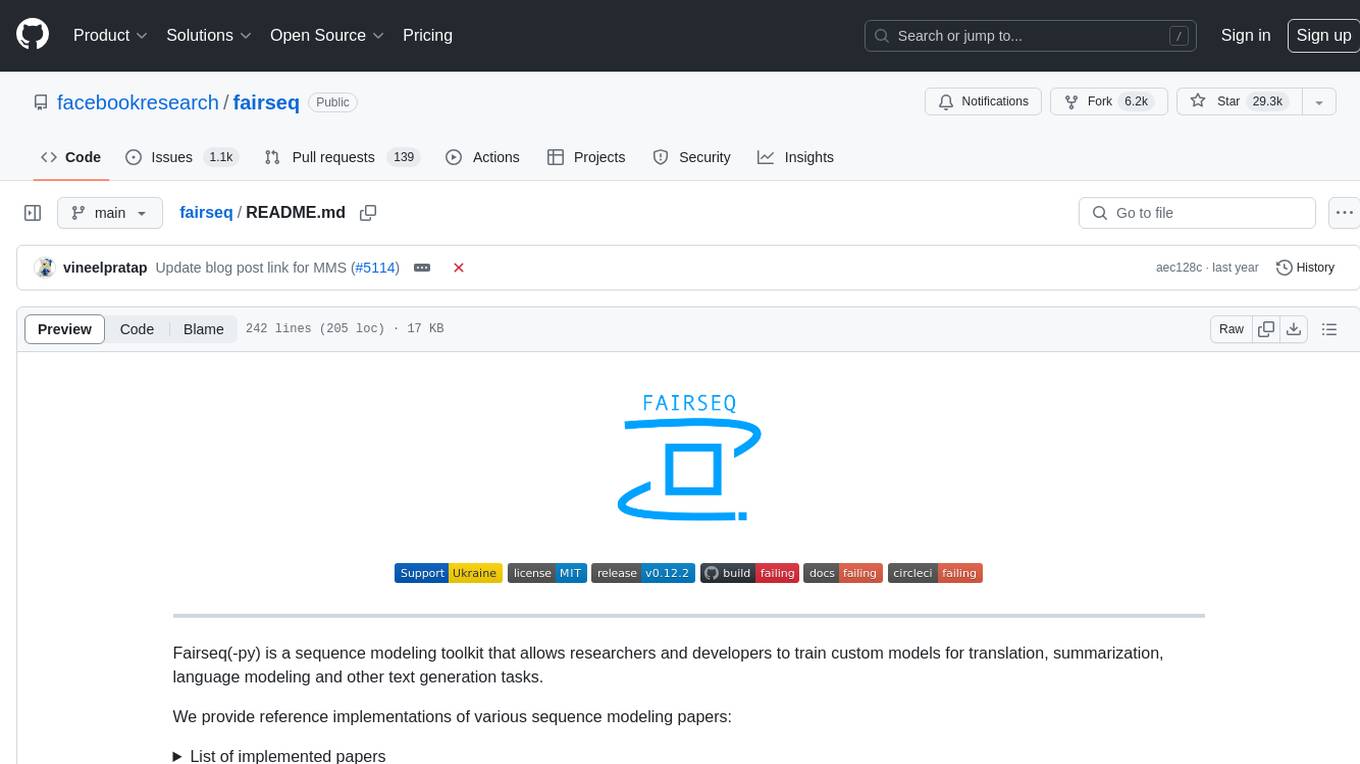
Fairseq is a sequence modeling toolkit that enables researchers and developers to train custom models for translation, summarization, language modeling, and other text generation tasks. It provides reference implementations of various sequence modeling papers covering CNN, LSTM networks, Transformer networks, LightConv, DynamicConv models, Non-autoregressive Transformers, Finetuning, and more. The toolkit supports multi-GPU training, fast generation on CPU and GPU, mixed precision training, extensibility, flexible configuration based on Hydra, and full parameter and optimizer state sharding. Pre-trained models are available for translation and language modeling with a torch.hub interface. Fairseq also offers pre-trained models and examples for tasks like XLS-R, cross-lingual retrieval, wav2vec 2.0, unsupervised quality estimation, and more.
README:
Fairseq(-py) is a sequence modeling toolkit that allows researchers and developers to train custom models for translation, summarization, language modeling and other text generation tasks.
We provide reference implementations of various sequence modeling papers:
List of implemented papers
-
Convolutional Neural Networks (CNN)
- Language Modeling with Gated Convolutional Networks (Dauphin et al., 2017)
- Convolutional Sequence to Sequence Learning (Gehring et al., 2017)
- Classical Structured Prediction Losses for Sequence to Sequence Learning (Edunov et al., 2018)
- Hierarchical Neural Story Generation (Fan et al., 2018)
- wav2vec: Unsupervised Pre-training for Speech Recognition (Schneider et al., 2019)
- LightConv and DynamicConv models
-
Long Short-Term Memory (LSTM) networks
- Effective Approaches to Attention-based Neural Machine Translation (Luong et al., 2015)
-
Transformer (self-attention) networks
- Attention Is All You Need (Vaswani et al., 2017)
- Scaling Neural Machine Translation (Ott et al., 2018)
- Understanding Back-Translation at Scale (Edunov et al., 2018)
- Adaptive Input Representations for Neural Language Modeling (Baevski and Auli, 2018)
- Lexically constrained decoding with dynamic beam allocation (Post & Vilar, 2018)
- Transformer-XL: Attentive Language Models Beyond a Fixed-Length Context (Dai et al., 2019)
- Adaptive Attention Span in Transformers (Sukhbaatar et al., 2019)
- Mixture Models for Diverse Machine Translation: Tricks of the Trade (Shen et al., 2019)
- RoBERTa: A Robustly Optimized BERT Pretraining Approach (Liu et al., 2019)
- Facebook FAIR's WMT19 News Translation Task Submission (Ng et al., 2019)
- Jointly Learning to Align and Translate with Transformer Models (Garg et al., 2019)
- Multilingual Denoising Pre-training for Neural Machine Translation (Liu et at., 2020)
- Neural Machine Translation with Byte-Level Subwords (Wang et al., 2020)
- Unsupervised Quality Estimation for Neural Machine Translation (Fomicheva et al., 2020)
- wav2vec 2.0: A Framework for Self-Supervised Learning of Speech Representations (Baevski et al., 2020)
- Generating Medical Reports from Patient-Doctor Conversations Using Sequence-to-Sequence Models (Enarvi et al., 2020)
- Linformer: Self-Attention with Linear Complexity (Wang et al., 2020)
- Cross-lingual Retrieval for Iterative Self-Supervised Training (Tran et al., 2020)
- Deep Transformers with Latent Depth (Li et al., 2020)
- Unsupervised Cross-lingual Representation Learning for Speech Recognition (Conneau et al., 2020)
- Self-training and Pre-training are Complementary for Speech Recognition (Xu et al., 2020)
- Robust wav2vec 2.0: Analyzing Domain Shift in Self-Supervised Pre-Training (Hsu, et al., 2021)
- Unsupervised Speech Recognition (Baevski, et al., 2021)
- Simple and Effective Zero-shot Cross-lingual Phoneme Recognition (Xu et al., 2021)
- VideoCLIP: Contrastive Pre-training for Zero-shot Video-Text Understanding (Xu et. al., 2021)
- VLM: Task-agnostic Video-Language Model Pre-training for Video Understanding (Xu et. al., 2021)
- NormFormer: Improved Transformer Pretraining with Extra Normalization (Shleifer et. al, 2021)
-
Non-autoregressive Transformers
- Non-Autoregressive Neural Machine Translation (Gu et al., 2017)
- Deterministic Non-Autoregressive Neural Sequence Modeling by Iterative Refinement (Lee et al. 2018)
- Insertion Transformer: Flexible Sequence Generation via Insertion Operations (Stern et al. 2019)
- Mask-Predict: Parallel Decoding of Conditional Masked Language Models (Ghazvininejad et al., 2019)
- Levenshtein Transformer (Gu et al., 2019)
- Finetuning
- May 2023 Released models for Scaling Speech Technology to 1,000+ Languages (Pratap, et al., 2023)
- June 2022 Released code for wav2vec-U 2.0 from Towards End-to-end Unsupervised Speech Recognition (Liu, et al., 2022)
- May 2022 Integration with xFormers
- December 2021 Released Direct speech-to-speech translation code
- October 2021 Released VideoCLIP and VLM models
- October 2021 Released multilingual finetuned XLSR-53 model
- September 2021
masterbranch renamed tomain. - July 2021 Released DrNMT code
- July 2021 Released Robust wav2vec 2.0 model
- June 2021 Released XLMR-XL and XLMR-XXL models
- May 2021 Released Unsupervised Speech Recognition code
- March 2021 Added full parameter and optimizer state sharding + CPU offloading
- February 2021 Added LASER training code
- December 2020: Added Adaptive Attention Span code
- December 2020: GottBERT model and code released
- November 2020: Adopted the Hydra configuration framework
- November 2020: fairseq 0.10.0 released
- October 2020: Added R3F/R4F (Better Fine-Tuning) code
- October 2020: Deep Transformer with Latent Depth code released
- October 2020: Added CRISS models and code
Previous updates
- September 2020: Added Linformer code
- September 2020: Added pointer-generator networks
- August 2020: Added lexically constrained decoding
- August 2020: wav2vec2 models and code released
- July 2020: Unsupervised Quality Estimation code released
- May 2020: Follow fairseq on Twitter
- April 2020: Monotonic Multihead Attention code released
- April 2020: Quant-Noise code released
- April 2020: Initial model parallel support and 11B parameters unidirectional LM released
- March 2020: Byte-level BPE code released
- February 2020: mBART model and code released
- February 2020: Added tutorial for back-translation
- December 2019: fairseq 0.9.0 released
- November 2019: VizSeq released (a visual analysis toolkit for evaluating fairseq models)
- November 2019: CamemBERT model and code released
- November 2019: BART model and code released
- November 2019: XLM-R models and code released
- September 2019: Nonautoregressive translation code released
- August 2019: WMT'19 models released
- July 2019: fairseq relicensed under MIT license
- July 2019: RoBERTa models and code released
- June 2019: wav2vec models and code released
- multi-GPU training on one machine or across multiple machines (data and model parallel)
- fast generation on both CPU and GPU with multiple search algorithms implemented:
- beam search
- Diverse Beam Search (Vijayakumar et al., 2016)
- sampling (unconstrained, top-k and top-p/nucleus)
- lexically constrained decoding (Post & Vilar, 2018)
- gradient accumulation enables training with large mini-batches even on a single GPU
- mixed precision training (trains faster with less GPU memory on NVIDIA tensor cores)
- extensible: easily register new models, criterions, tasks, optimizers and learning rate schedulers
- flexible configuration based on Hydra allowing a combination of code, command-line and file based configuration
- full parameter and optimizer state sharding
- offloading parameters to CPU
We also provide pre-trained models for translation and language modeling
with a convenient torch.hub interface:
en2de = torch.hub.load('pytorch/fairseq', 'transformer.wmt19.en-de.single_model')
en2de.translate('Hello world', beam=5)
# 'Hallo Welt'See the PyTorch Hub tutorials for translation and RoBERTa for more examples.
- PyTorch version >= 1.10.0
- Python version >= 3.8
- For training new models, you'll also need an NVIDIA GPU and NCCL
- To install fairseq and develop locally:
git clone https://github.com/pytorch/fairseq
cd fairseq
pip install --editable ./
# on MacOS:
# CFLAGS="-stdlib=libc++" pip install --editable ./
# to install the latest stable release (0.10.x)
# pip install fairseq- For faster training install NVIDIA's apex library:
git clone https://github.com/NVIDIA/apex
cd apex
pip install -v --no-cache-dir --global-option="--cpp_ext" --global-option="--cuda_ext" \
--global-option="--deprecated_fused_adam" --global-option="--xentropy" \
--global-option="--fast_multihead_attn" ./-
For large datasets install PyArrow:
pip install pyarrow - If you use Docker make sure to increase the shared memory size either with
--ipc=hostor--shm-sizeas command line options tonvidia-docker run.
The full documentation contains instructions for getting started, training new models and extending fairseq with new model types and tasks.
We provide pre-trained models and pre-processed, binarized test sets for several tasks listed below, as well as example training and evaluation commands.
- Translation: convolutional and transformer models are available
- Language Modeling: convolutional and transformer models are available
We also have more detailed READMEs to reproduce results from specific papers:
- XLS-R: Self-supervised Cross-lingual Speech Representation Learning at Scale (Babu et al., 2021)
- Cross-lingual Retrieval for Iterative Self-Supervised Training (Tran et al., 2020)
- wav2vec 2.0: A Framework for Self-Supervised Learning of Speech Representations (Baevski et al., 2020)
- Unsupervised Quality Estimation for Neural Machine Translation (Fomicheva et al., 2020)
- Training with Quantization Noise for Extreme Model Compression ({Fan*, Stock*} et al., 2020)
- Neural Machine Translation with Byte-Level Subwords (Wang et al., 2020)
- Multilingual Denoising Pre-training for Neural Machine Translation (Liu et at., 2020)
- Reducing Transformer Depth on Demand with Structured Dropout (Fan et al., 2019)
- Jointly Learning to Align and Translate with Transformer Models (Garg et al., 2019)
- Levenshtein Transformer (Gu et al., 2019)
- Facebook FAIR's WMT19 News Translation Task Submission (Ng et al., 2019)
- RoBERTa: A Robustly Optimized BERT Pretraining Approach (Liu et al., 2019)
- wav2vec: Unsupervised Pre-training for Speech Recognition (Schneider et al., 2019)
- Mixture Models for Diverse Machine Translation: Tricks of the Trade (Shen et al., 2019)
- Pay Less Attention with Lightweight and Dynamic Convolutions (Wu et al., 2019)
- Understanding Back-Translation at Scale (Edunov et al., 2018)
- Classical Structured Prediction Losses for Sequence to Sequence Learning (Edunov et al., 2018)
- Hierarchical Neural Story Generation (Fan et al., 2018)
- Scaling Neural Machine Translation (Ott et al., 2018)
- Convolutional Sequence to Sequence Learning (Gehring et al., 2017)
- Language Modeling with Gated Convolutional Networks (Dauphin et al., 2017)
- Twitter: https://twitter.com/fairseq
- Facebook page: https://www.facebook.com/groups/fairseq.users
- Google group: https://groups.google.com/forum/#!forum/fairseq-users
fairseq(-py) is MIT-licensed. The license applies to the pre-trained models as well.
Please cite as:
@inproceedings{ott2019fairseq,
title = {fairseq: A Fast, Extensible Toolkit for Sequence Modeling},
author = {Myle Ott and Sergey Edunov and Alexei Baevski and Angela Fan and Sam Gross and Nathan Ng and David Grangier and Michael Auli},
booktitle = {Proceedings of NAACL-HLT 2019: Demonstrations},
year = {2019},
}For Tasks:
Click tags to check more tools for each tasksFor Jobs:
Alternative AI tools for fairseq
Similar Open Source Tools

fairseq
Fairseq is a sequence modeling toolkit that enables researchers and developers to train custom models for translation, summarization, language modeling, and other text generation tasks. It provides reference implementations of various sequence modeling papers covering CNN, LSTM networks, Transformer networks, LightConv, DynamicConv models, Non-autoregressive Transformers, Finetuning, and more. The toolkit supports multi-GPU training, fast generation on CPU and GPU, mixed precision training, extensibility, flexible configuration based on Hydra, and full parameter and optimizer state sharding. Pre-trained models are available for translation and language modeling with a torch.hub interface. Fairseq also offers pre-trained models and examples for tasks like XLS-R, cross-lingual retrieval, wav2vec 2.0, unsupervised quality estimation, and more.
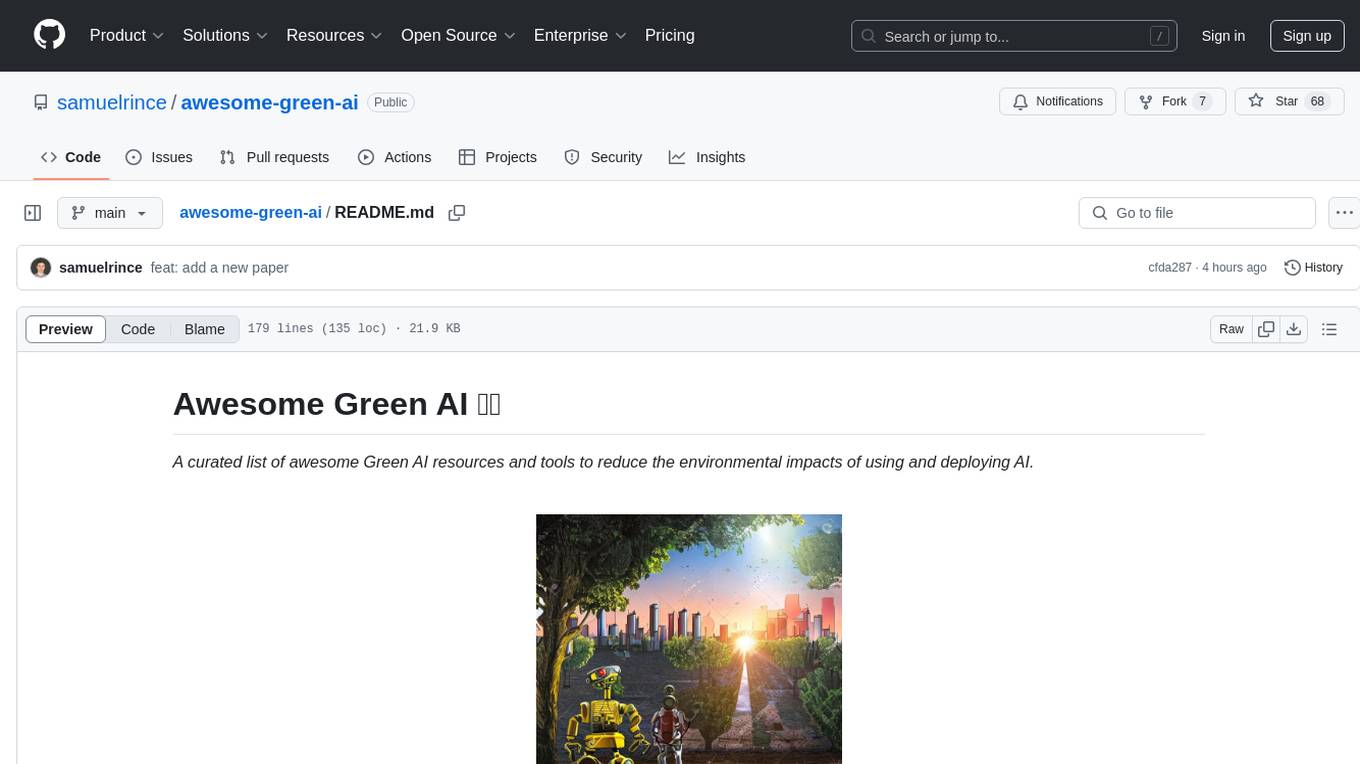
awesome-green-ai
Awesome Green AI is a curated list of resources and tools aimed at reducing the environmental impacts of using and deploying AI. It addresses the carbon footprint of the ICT sector, emphasizing the importance of AI in reducing environmental impacts beyond GHG emissions and electricity consumption. The tools listed cover code-based tools for measuring environmental impacts, monitoring tools for power consumption, optimization tools for energy efficiency, and calculation tools for estimating environmental impacts of algorithms and models. The repository also includes leaderboards, papers, survey papers, and reports related to green AI and environmental sustainability in the AI sector.
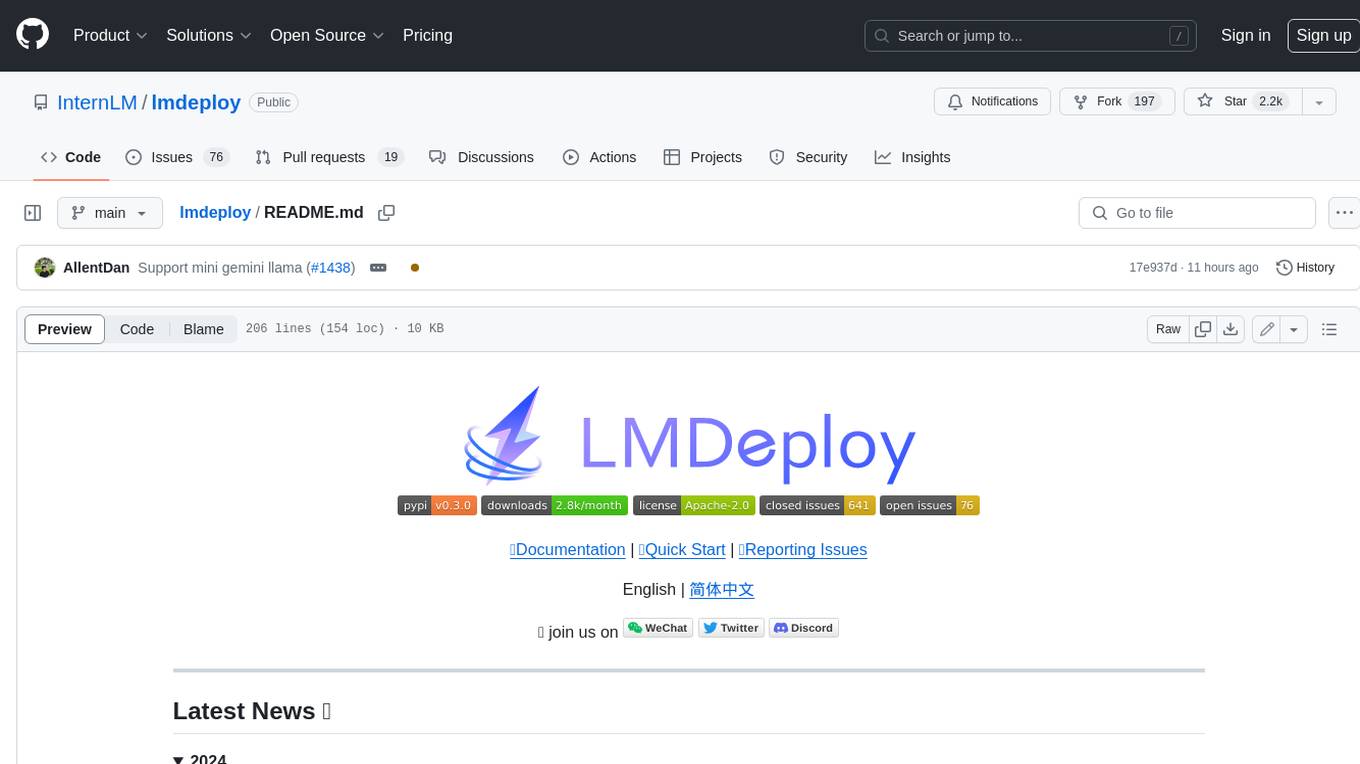
lmdeploy
LMDeploy is a toolkit for compressing, deploying, and serving LLM, developed by the MMRazor and MMDeploy teams. It has the following core features: * **Efficient Inference** : LMDeploy delivers up to 1.8x higher request throughput than vLLM, by introducing key features like persistent batch(a.k.a. continuous batching), blocked KV cache, dynamic split&fuse, tensor parallelism, high-performance CUDA kernels and so on. * **Effective Quantization** : LMDeploy supports weight-only and k/v quantization, and the 4-bit inference performance is 2.4x higher than FP16. The quantization quality has been confirmed via OpenCompass evaluation. * **Effortless Distribution Server** : Leveraging the request distribution service, LMDeploy facilitates an easy and efficient deployment of multi-model services across multiple machines and cards. * **Interactive Inference Mode** : By caching the k/v of attention during multi-round dialogue processes, the engine remembers dialogue history, thus avoiding repetitive processing of historical sessions.
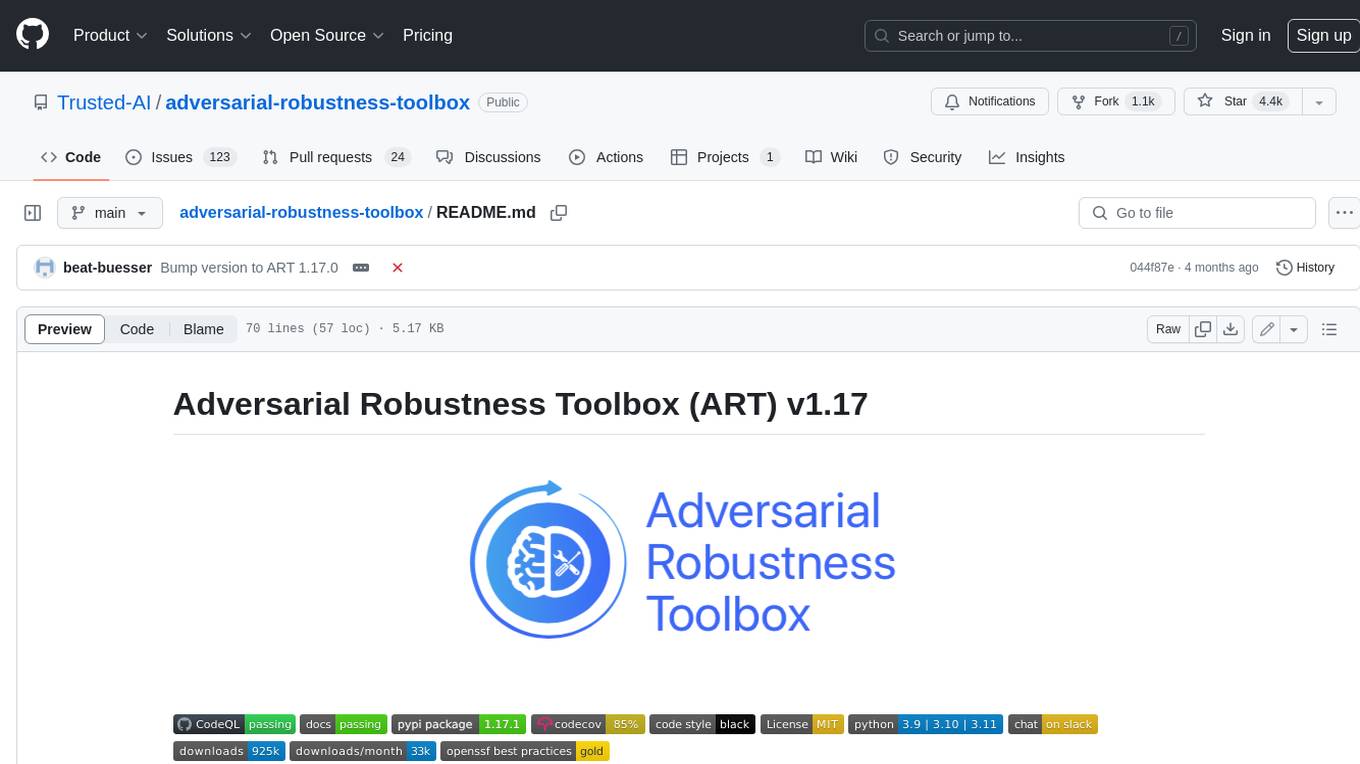
adversarial-robustness-toolbox
Adversarial Robustness Toolbox (ART) is a Python library for Machine Learning Security. ART provides tools that enable developers and researchers to defend and evaluate Machine Learning models and applications against the adversarial threats of Evasion, Poisoning, Extraction, and Inference. ART supports all popular machine learning frameworks (TensorFlow, Keras, PyTorch, MXNet, scikit-learn, XGBoost, LightGBM, CatBoost, GPy, etc.), all data types (images, tables, audio, video, etc.) and machine learning tasks (classification, object detection, speech recognition, generation, certification, etc.).
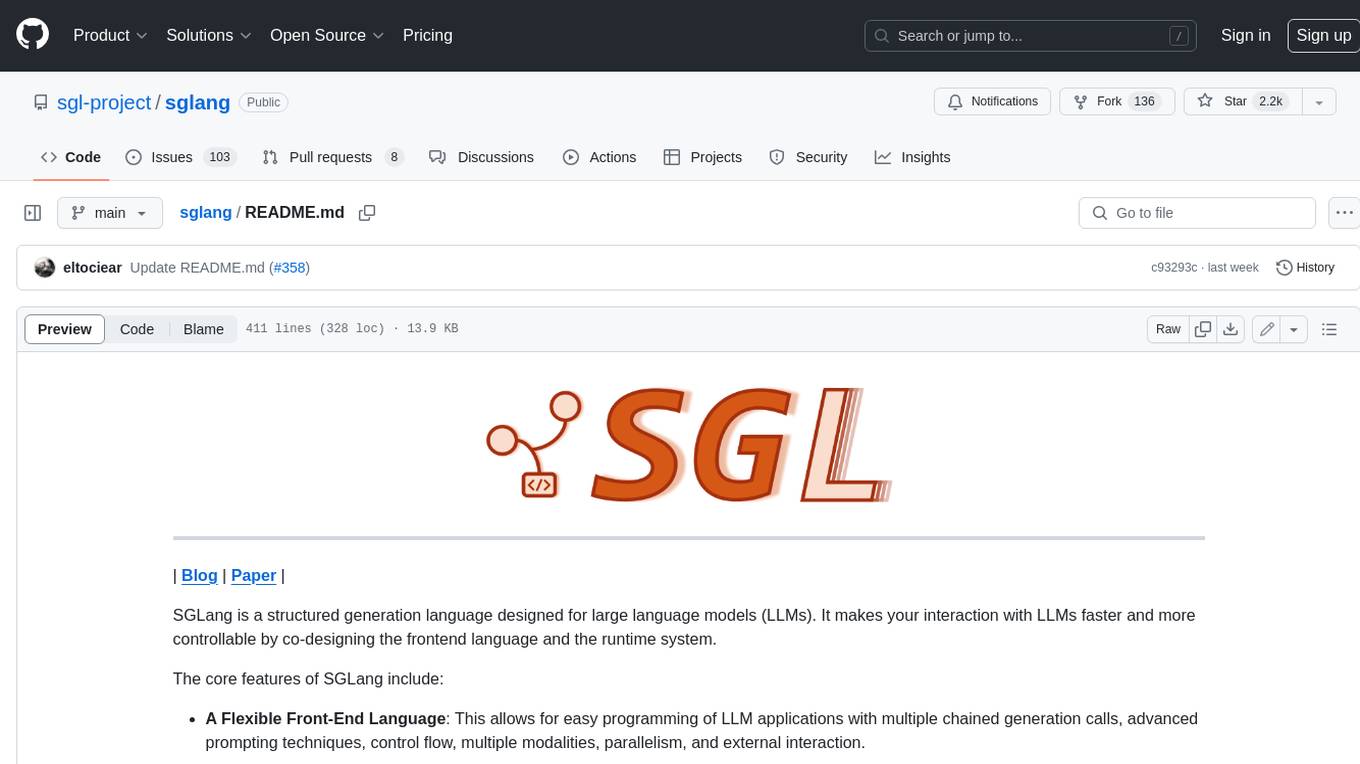
sglang
SGLang is a structured generation language designed for large language models (LLMs). It makes your interaction with LLMs faster and more controllable by co-designing the frontend language and the runtime system. The core features of SGLang include: - **A Flexible Front-End Language**: This allows for easy programming of LLM applications with multiple chained generation calls, advanced prompting techniques, control flow, multiple modalities, parallelism, and external interaction. - **A High-Performance Runtime with RadixAttention**: This feature significantly accelerates the execution of complex LLM programs by automatic KV cache reuse across multiple calls. It also supports other common techniques like continuous batching and tensor parallelism.
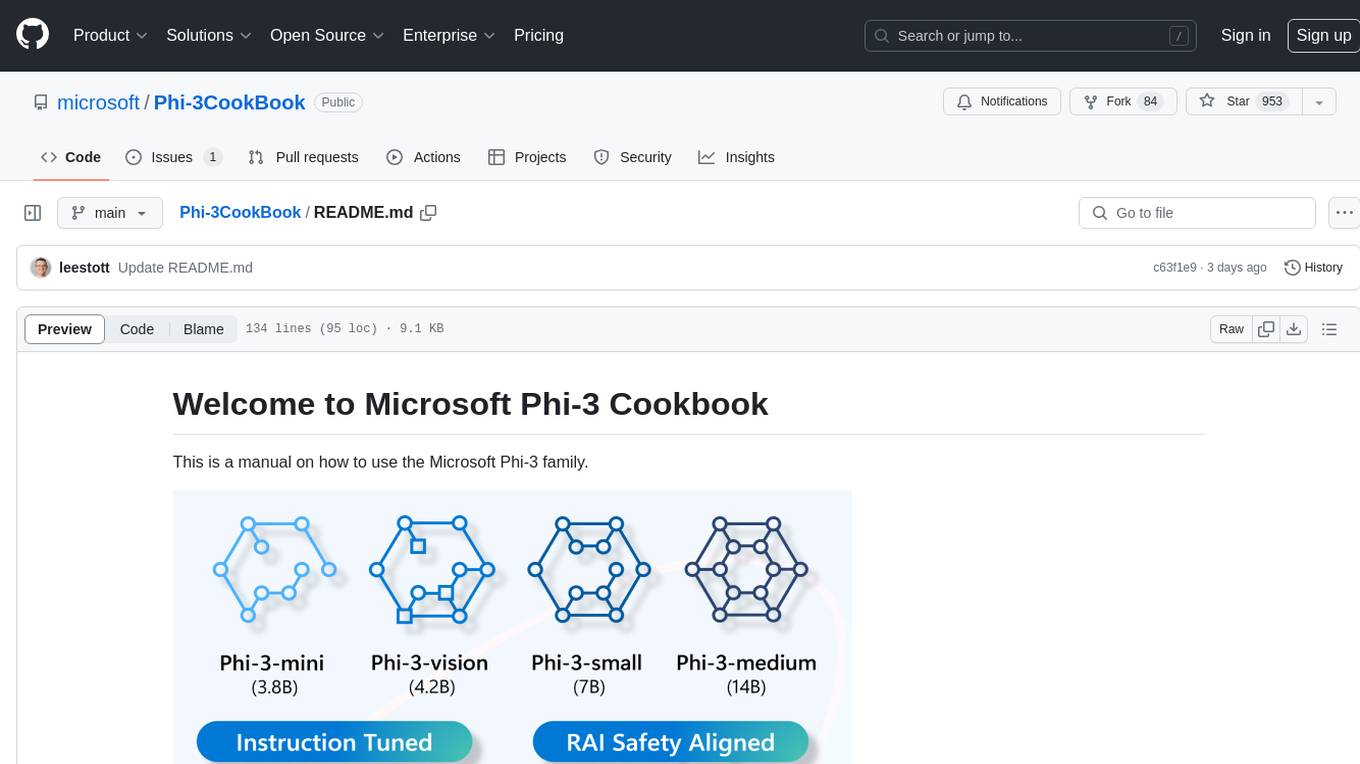
Phi-3CookBook
Phi-3CookBook is a manual on how to use the Microsoft Phi-3 family, which consists of open AI models developed by Microsoft. The Phi-3 models are highly capable and cost-effective small language models, outperforming models of similar and larger sizes across various language, reasoning, coding, and math benchmarks. The repository provides detailed information on different Phi-3 models, their performance, availability, and usage scenarios across different platforms like Azure AI Studio, Hugging Face, and Ollama. It also covers topics such as fine-tuning, evaluation, and end-to-end samples for Phi-3-mini and Phi-3-vision models, along with labs, workshops, and contributing guidelines.
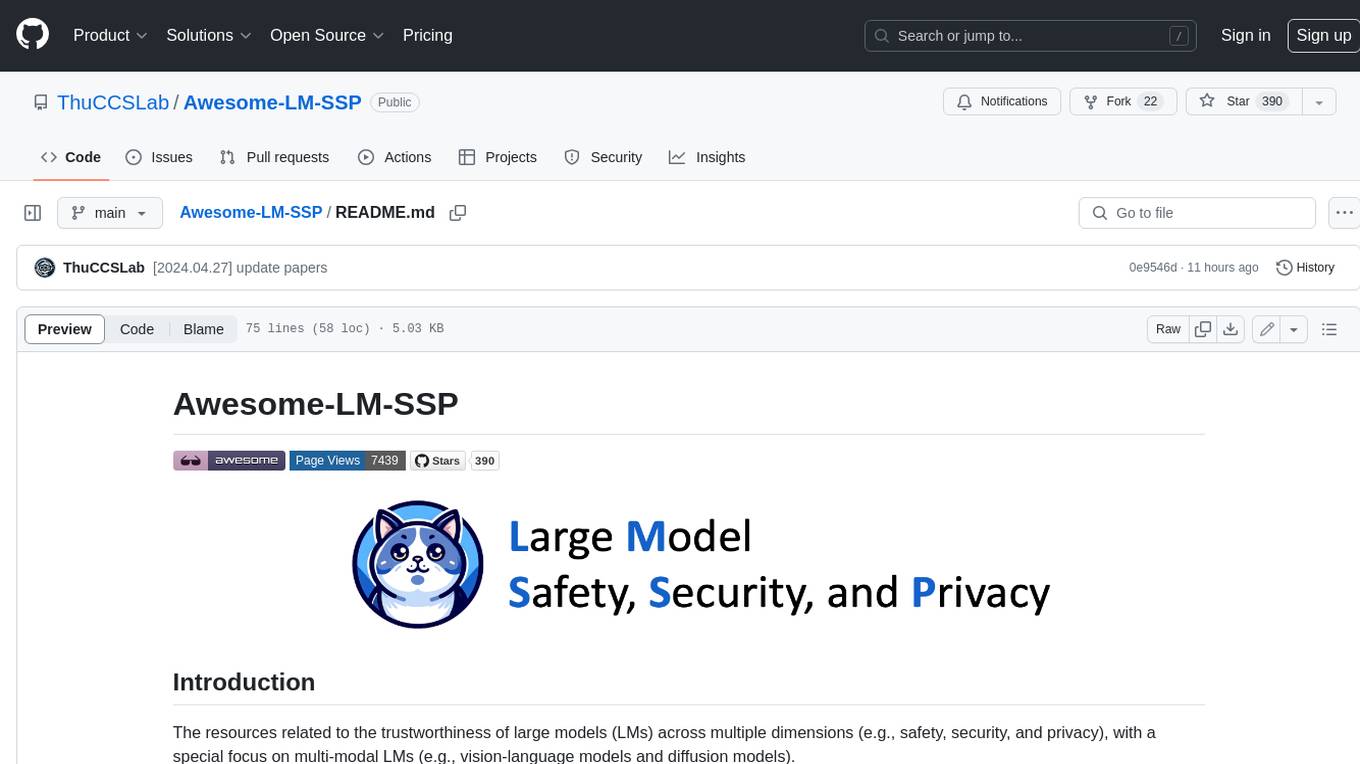
Awesome-LM-SSP
The Awesome-LM-SSP repository is a collection of resources related to the trustworthiness of large models (LMs) across multiple dimensions, with a special focus on multi-modal LMs. It includes papers, surveys, toolkits, competitions, and leaderboards. The resources are categorized into three main dimensions: safety, security, and privacy. Within each dimension, there are several subcategories. For example, the safety dimension includes subcategories such as jailbreak, alignment, deepfake, ethics, fairness, hallucination, prompt injection, and toxicity. The security dimension includes subcategories such as adversarial examples, poisoning, and system security. The privacy dimension includes subcategories such as contamination, copyright, data reconstruction, membership inference attacks, model extraction, privacy-preserving computation, and unlearning.
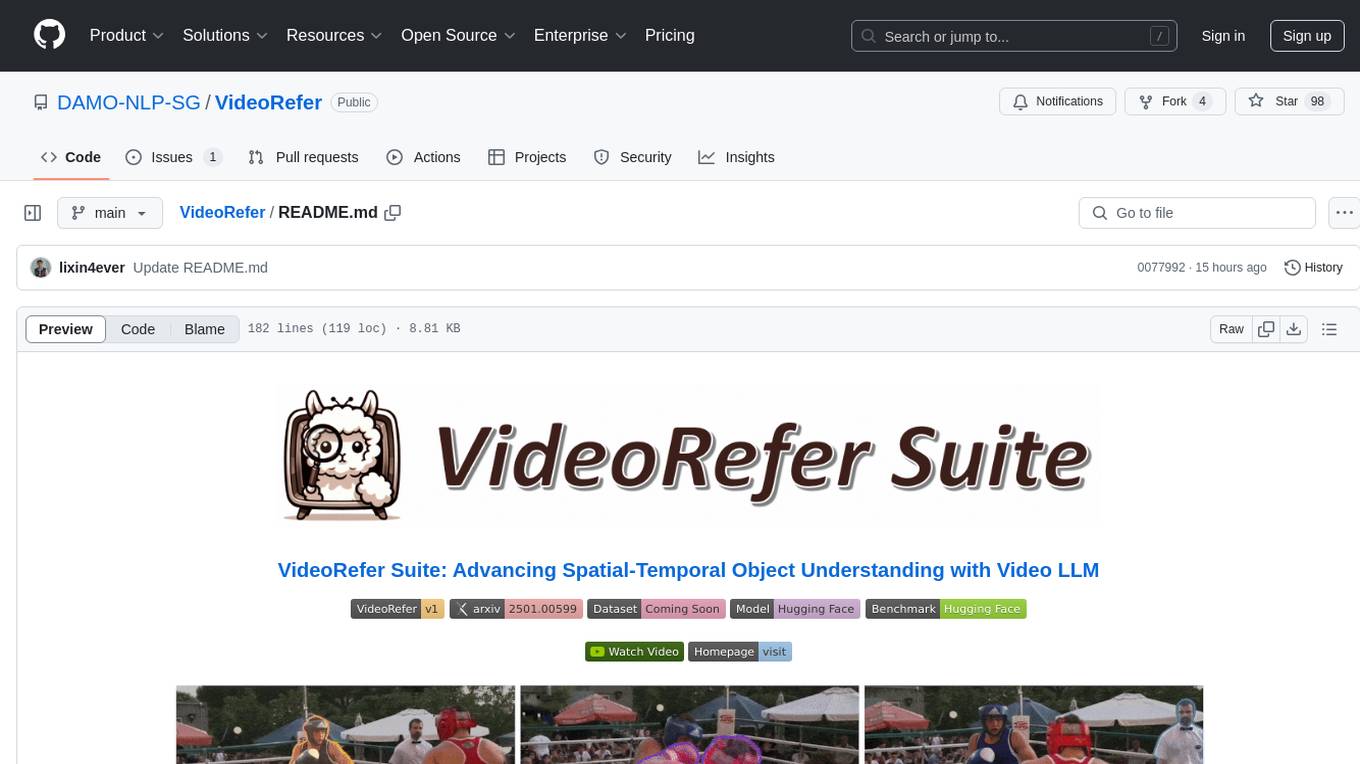
VideoRefer
VideoRefer Suite is a tool designed to enhance the fine-grained spatial-temporal understanding capabilities of Video Large Language Models (Video LLMs). It consists of three primary components: Model (VideoRefer) for perceiving, reasoning, and retrieval for user-defined regions at any specified timestamps, Dataset (VideoRefer-700K) for high-quality object-level video instruction data, and Benchmark (VideoRefer-Bench) to evaluate object-level video understanding capabilities. The tool can understand any object within a video.
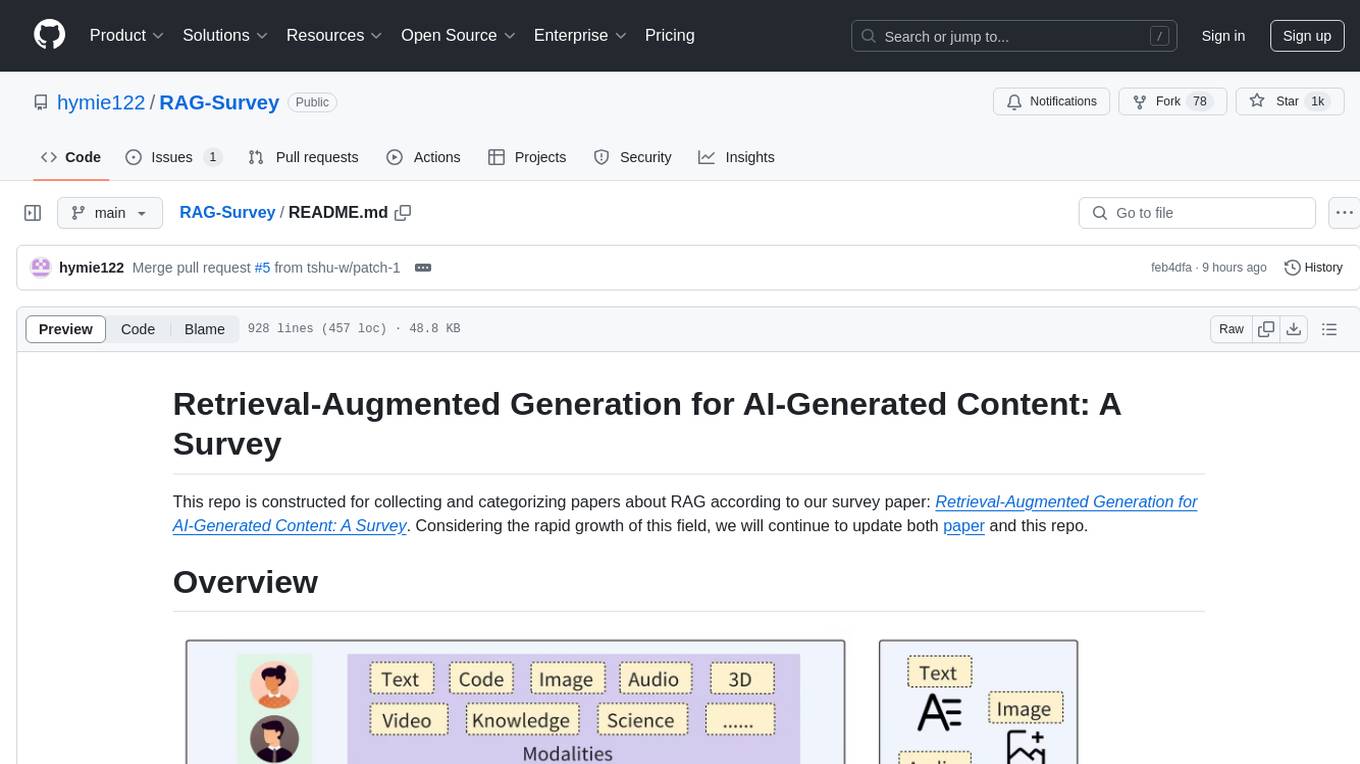
RAG-Survey
This repository is dedicated to collecting and categorizing papers related to Retrieval-Augmented Generation (RAG) for AI-generated content. It serves as a survey repository based on the paper 'Retrieval-Augmented Generation for AI-Generated Content: A Survey'. The repository is continuously updated to keep up with the rapid growth in the field of RAG.
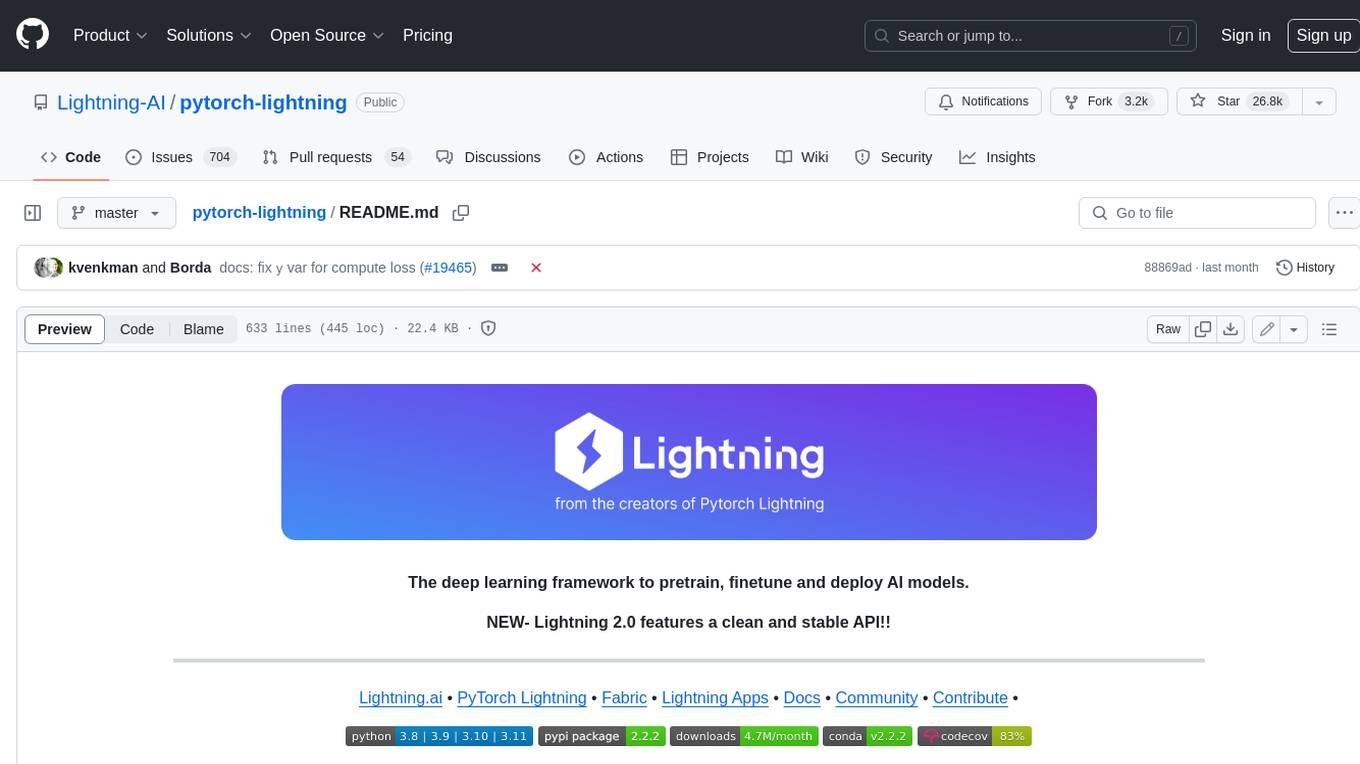
pytorch-lightning
PyTorch Lightning is a framework for training and deploying AI models. It provides a high-level API that abstracts away the low-level details of PyTorch, making it easier to write and maintain complex models. Lightning also includes a number of features that make it easy to train and deploy models on multiple GPUs or TPUs, and to track and visualize training progress. PyTorch Lightning is used by a wide range of organizations, including Google, Facebook, and Microsoft. It is also used by researchers at top universities around the world. Here are some of the benefits of using PyTorch Lightning: * **Increased productivity:** Lightning's high-level API makes it easy to write and maintain complex models. This can save you time and effort, and allow you to focus on the research or business problem you're trying to solve. * **Improved performance:** Lightning's optimized training loops and data loading pipelines can help you train models faster and with better performance. * **Easier deployment:** Lightning makes it easy to deploy models to a variety of platforms, including the cloud, on-premises servers, and mobile devices. * **Better reproducibility:** Lightning's logging and visualization tools make it easy to track and reproduce training results.
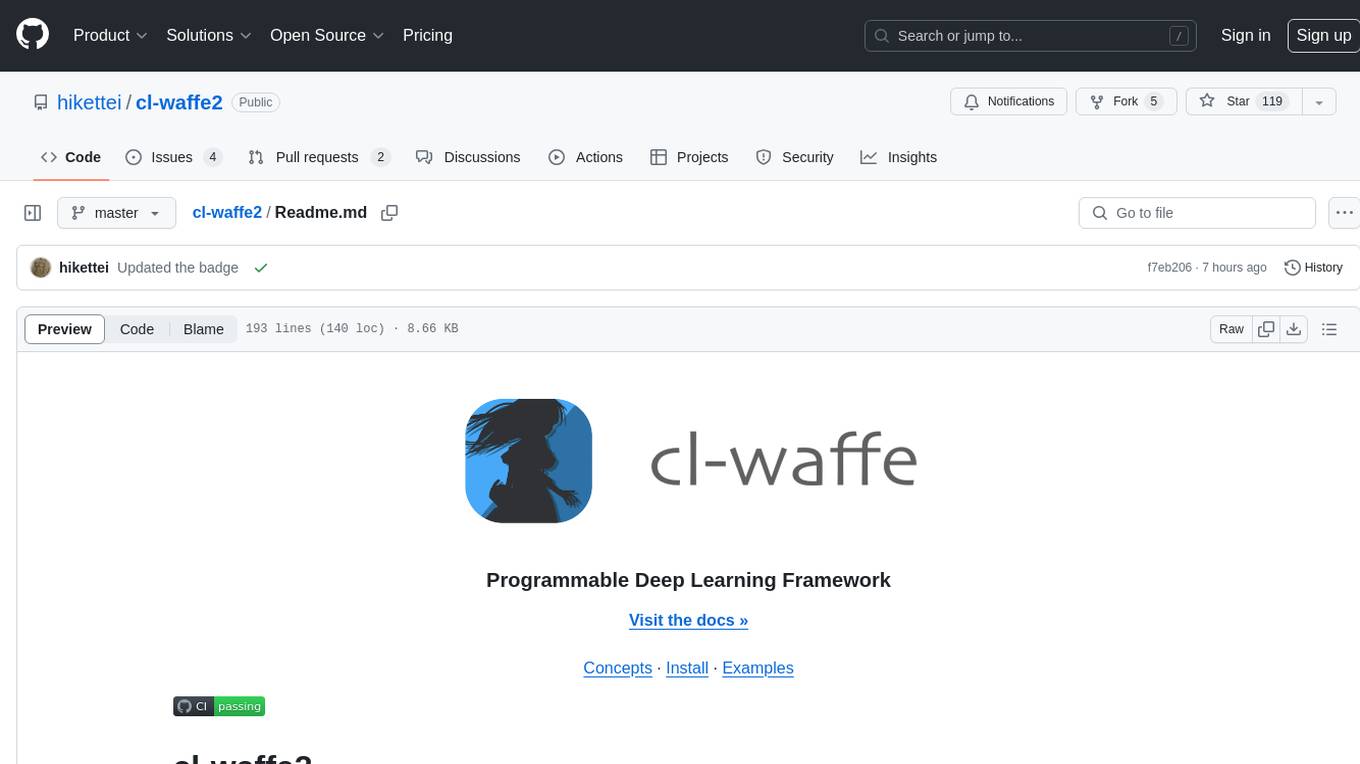
cl-waffe2
cl-waffe2 is an experimental deep learning framework in Common Lisp, providing fast, systematic, and customizable matrix operations, reverse mode tape-based Automatic Differentiation, and neural network model building and training features accelerated by a JIT Compiler. It offers abstraction layers, extensibility, inlining, graph-level optimization, visualization, debugging, systematic nodes, and symbolic differentiation. Users can easily write extensions and optimize their networks without overheads. The framework is designed to eliminate barriers between users and developers, allowing for easy customization and extension.
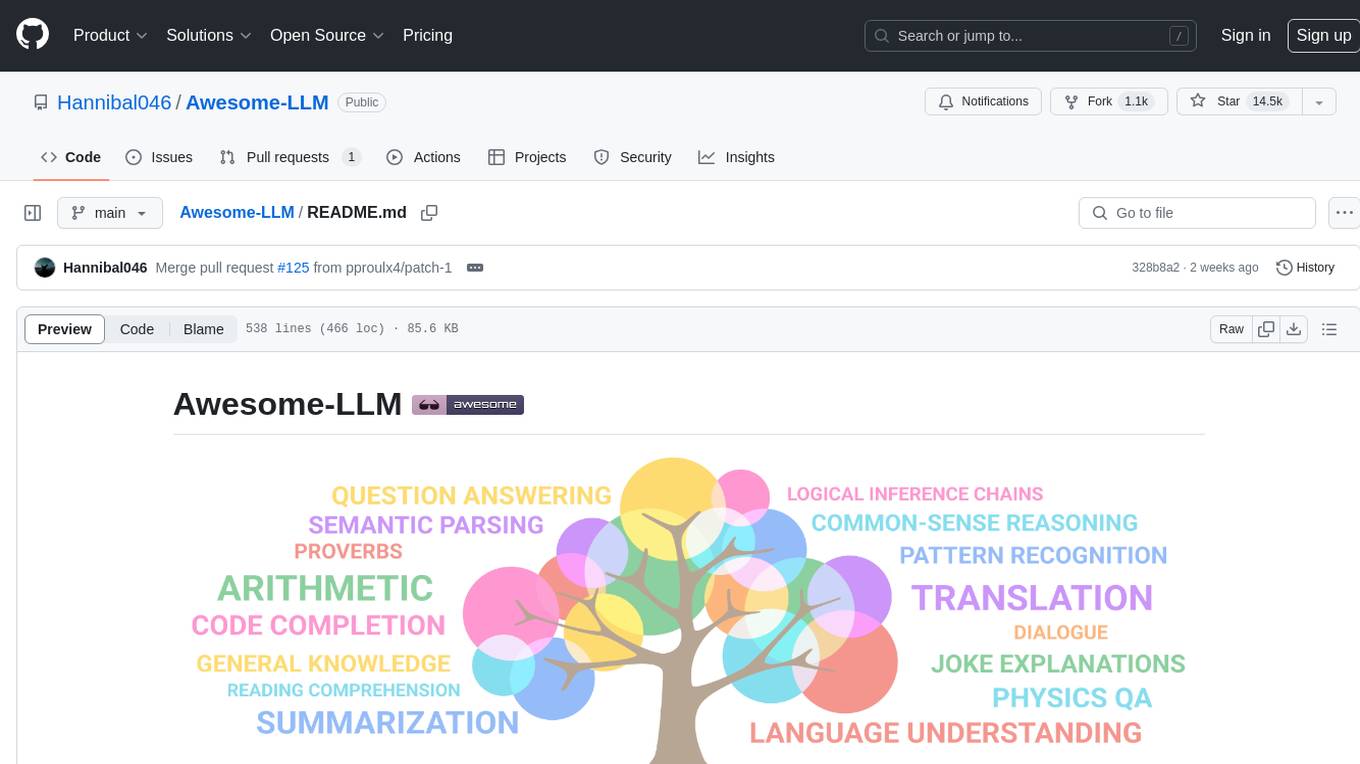
Awesome-LLM
Awesome-LLM is a curated list of resources related to large language models, focusing on papers, projects, frameworks, tools, tutorials, courses, opinions, and other useful resources in the field. It covers trending LLM projects, milestone papers, other papers, open LLM projects, LLM training frameworks, LLM evaluation frameworks, tools for deploying LLM, prompting libraries & tools, tutorials, courses, books, and opinions. The repository provides a comprehensive overview of the latest advancements and resources in the field of large language models.
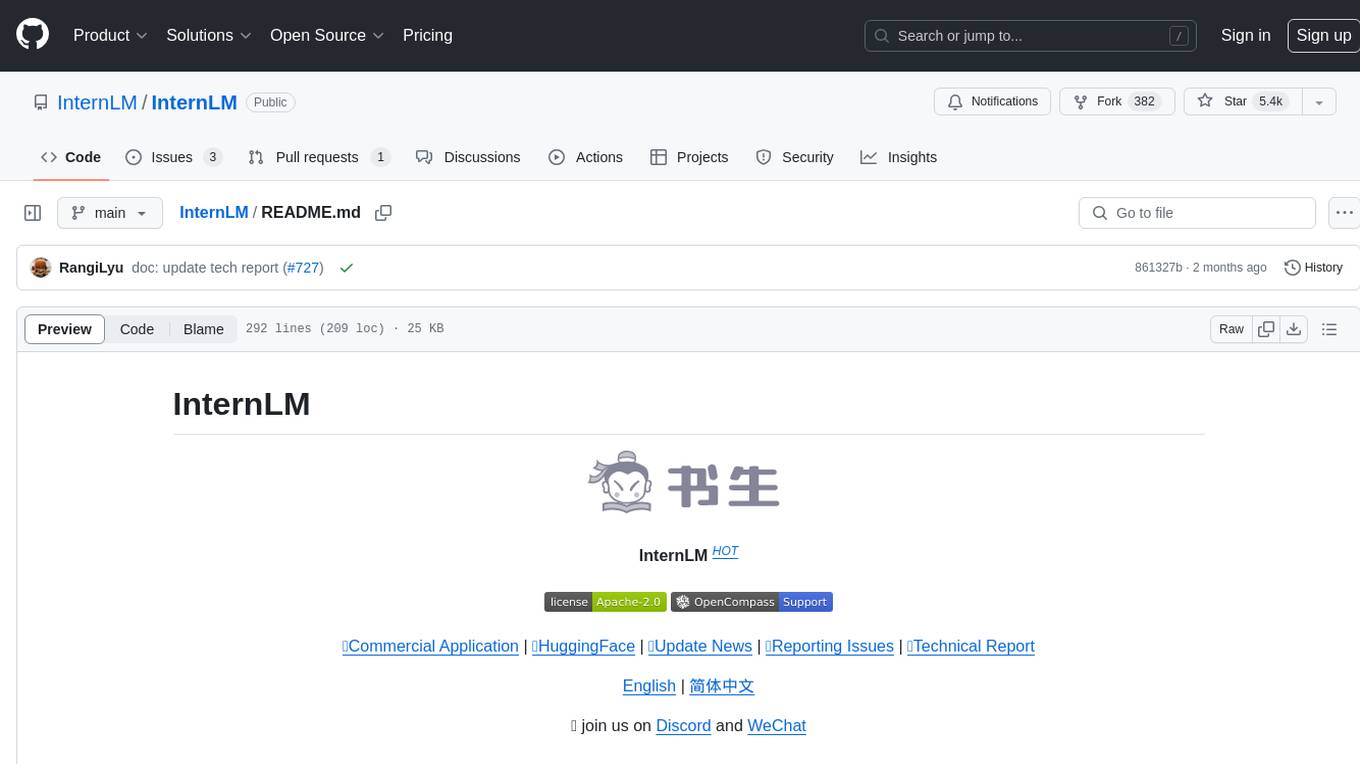
InternLM
InternLM is a powerful language model series with features such as 200K context window for long-context tasks, outstanding comprehensive performance in reasoning, math, code, chat experience, instruction following, and creative writing, code interpreter & data analysis capabilities, and stronger tool utilization capabilities. It offers models in sizes of 7B and 20B, suitable for research and complex scenarios. The models are recommended for various applications and exhibit better performance than previous generations. InternLM models may match or surpass other open-source models like ChatGPT. The tool has been evaluated on various datasets and has shown superior performance in multiple tasks. It requires Python >= 3.8, PyTorch >= 1.12.0, and Transformers >= 4.34 for usage. InternLM can be used for tasks like chat, agent applications, fine-tuning, deployment, and long-context inference.
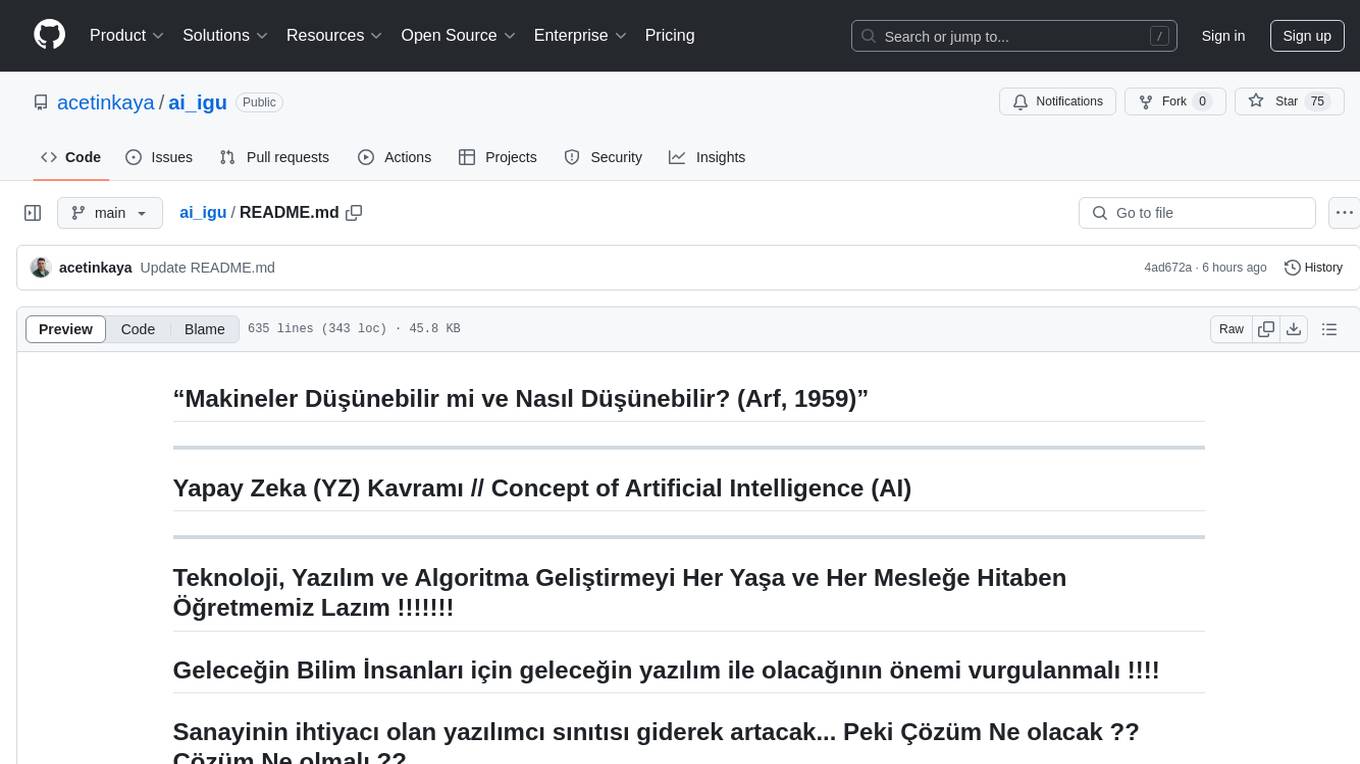
ai_igu
AI-IGU is a GitHub repository focused on Artificial Intelligence (AI) concepts, technology, software development, and algorithm improvement for all ages and professions. It emphasizes the importance of future software for future scientists and the increasing need for software developers in the industry. The repository covers various topics related to AI, including machine learning, deep learning, data mining, data science, big data, and more. It provides educational materials, practical examples, and hands-on projects to enhance software development skills and create awareness in the field of AI.
For similar tasks

LLMStack
LLMStack is a no-code platform for building generative AI agents, workflows, and chatbots. It allows users to connect their own data, internal tools, and GPT-powered models without any coding experience. LLMStack can be deployed to the cloud or on-premise and can be accessed via HTTP API or triggered from Slack or Discord.
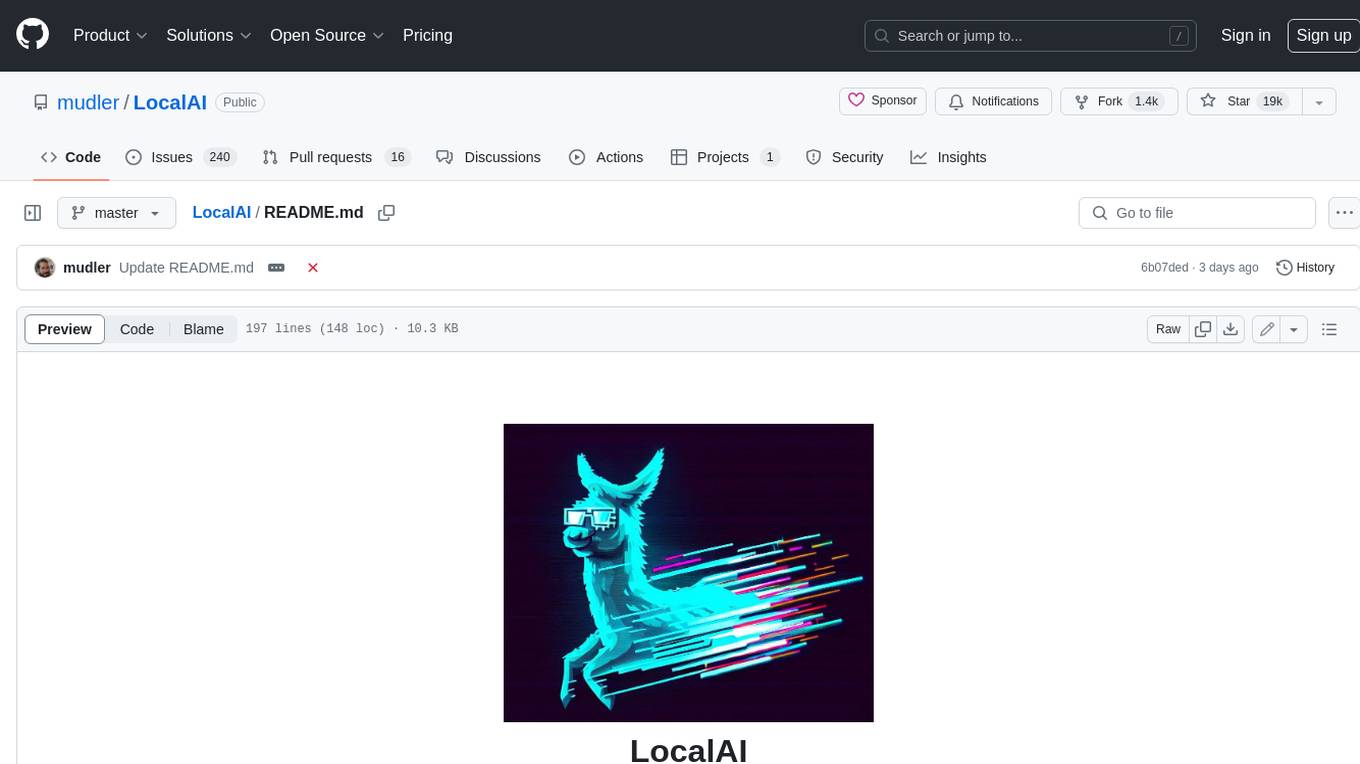
LocalAI
LocalAI is a free and open-source OpenAI alternative that acts as a drop-in replacement REST API compatible with OpenAI (Elevenlabs, Anthropic, etc.) API specifications for local AI inferencing. It allows users to run LLMs, generate images, audio, and more locally or on-premises with consumer-grade hardware, supporting multiple model families and not requiring a GPU. LocalAI offers features such as text generation with GPTs, text-to-audio, audio-to-text transcription, image generation with stable diffusion, OpenAI functions, embeddings generation for vector databases, constrained grammars, downloading models directly from Huggingface, and a Vision API. It provides a detailed step-by-step introduction in its Getting Started guide and supports community integrations such as custom containers, WebUIs, model galleries, and various bots for Discord, Slack, and Telegram. LocalAI also offers resources like an LLM fine-tuning guide, instructions for local building and Kubernetes installation, projects integrating LocalAI, and a how-tos section curated by the community. It encourages users to cite the repository when utilizing it in downstream projects and acknowledges the contributions of various software from the community.
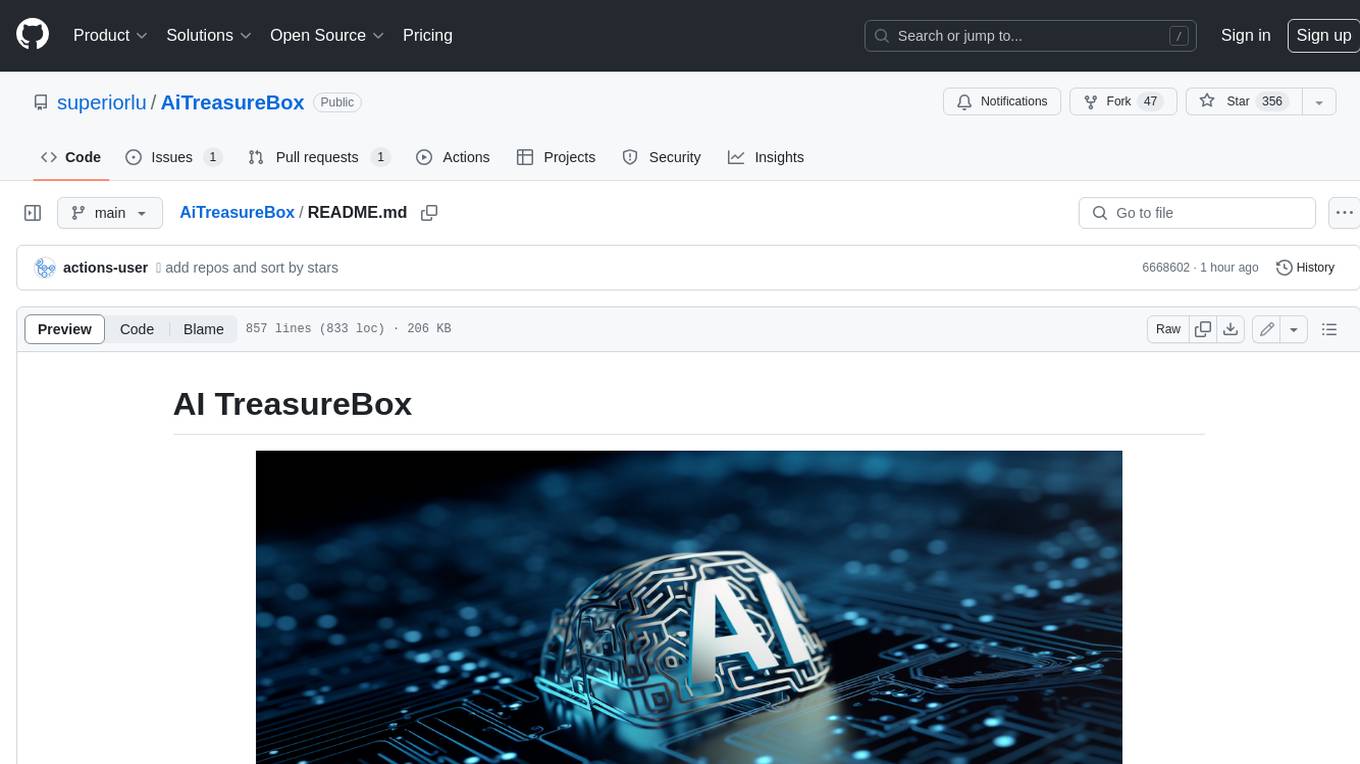
AiTreasureBox
AiTreasureBox is a versatile AI tool that provides a collection of pre-trained models and algorithms for various machine learning tasks. It simplifies the process of implementing AI solutions by offering ready-to-use components that can be easily integrated into projects. With AiTreasureBox, users can quickly prototype and deploy AI applications without the need for extensive knowledge in machine learning or deep learning. The tool covers a wide range of tasks such as image classification, text generation, sentiment analysis, object detection, and more. It is designed to be user-friendly and accessible to both beginners and experienced developers, making AI development more efficient and accessible to a wider audience.
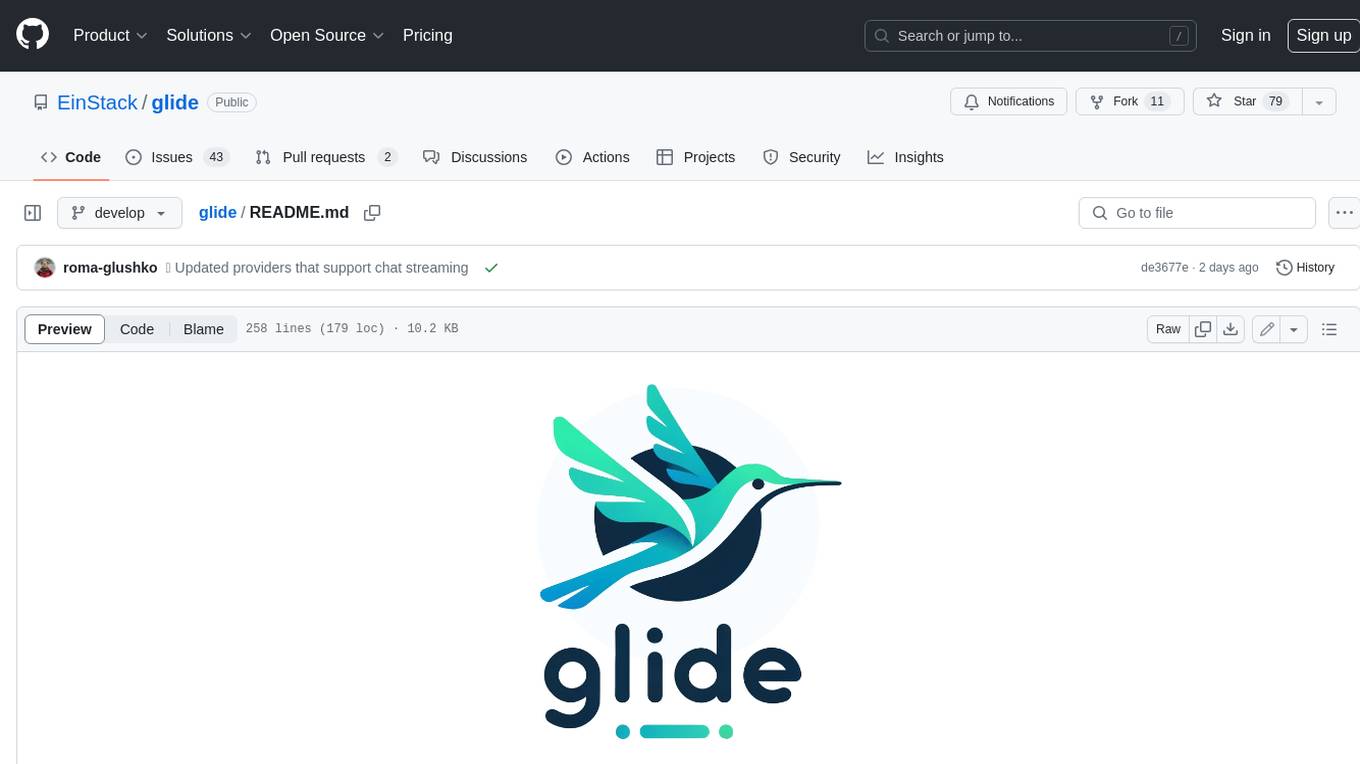
glide
Glide is a cloud-native LLM gateway that provides a unified REST API for accessing various large language models (LLMs) from different providers. It handles LLMOps tasks such as model failover, caching, key management, and more, making it easy to integrate LLMs into applications. Glide supports popular LLM providers like OpenAI, Anthropic, Azure OpenAI, AWS Bedrock (Titan), Cohere, Google Gemini, OctoML, and Ollama. It offers high availability, performance, and observability, and provides SDKs for Python and NodeJS to simplify integration.
jupyter-ai
Jupyter AI connects generative AI with Jupyter notebooks. It provides a user-friendly and powerful way to explore generative AI models in notebooks and improve your productivity in JupyterLab and the Jupyter Notebook. Specifically, Jupyter AI offers: * An `%%ai` magic that turns the Jupyter notebook into a reproducible generative AI playground. This works anywhere the IPython kernel runs (JupyterLab, Jupyter Notebook, Google Colab, Kaggle, VSCode, etc.). * A native chat UI in JupyterLab that enables you to work with generative AI as a conversational assistant. * Support for a wide range of generative model providers, including AI21, Anthropic, AWS, Cohere, Gemini, Hugging Face, NVIDIA, and OpenAI. * Local model support through GPT4All, enabling use of generative AI models on consumer grade machines with ease and privacy.

langchain_dart
LangChain.dart is a Dart port of the popular LangChain Python framework created by Harrison Chase. LangChain provides a set of ready-to-use components for working with language models and a standard interface for chaining them together to formulate more advanced use cases (e.g. chatbots, Q&A with RAG, agents, summarization, extraction, etc.). The components can be grouped into a few core modules: * **Model I/O:** LangChain offers a unified API for interacting with various LLM providers (e.g. OpenAI, Google, Mistral, Ollama, etc.), allowing developers to switch between them with ease. Additionally, it provides tools for managing model inputs (prompt templates and example selectors) and parsing the resulting model outputs (output parsers). * **Retrieval:** assists in loading user data (via document loaders), transforming it (with text splitters), extracting its meaning (using embedding models), storing (in vector stores) and retrieving it (through retrievers) so that it can be used to ground the model's responses (i.e. Retrieval-Augmented Generation or RAG). * **Agents:** "bots" that leverage LLMs to make informed decisions about which available tools (such as web search, calculators, database lookup, etc.) to use to accomplish the designated task. The different components can be composed together using the LangChain Expression Language (LCEL).
infinity
Infinity is an AI-native database designed for LLM applications, providing incredibly fast full-text and vector search capabilities. It supports a wide range of data types, including vectors, full-text, and structured data, and offers a fused search feature that combines multiple embeddings and full text. Infinity is easy to use, with an intuitive Python API and a single-binary architecture that simplifies deployment. It achieves high performance, with 0.1 milliseconds query latency on million-scale vector datasets and up to 15K QPS.
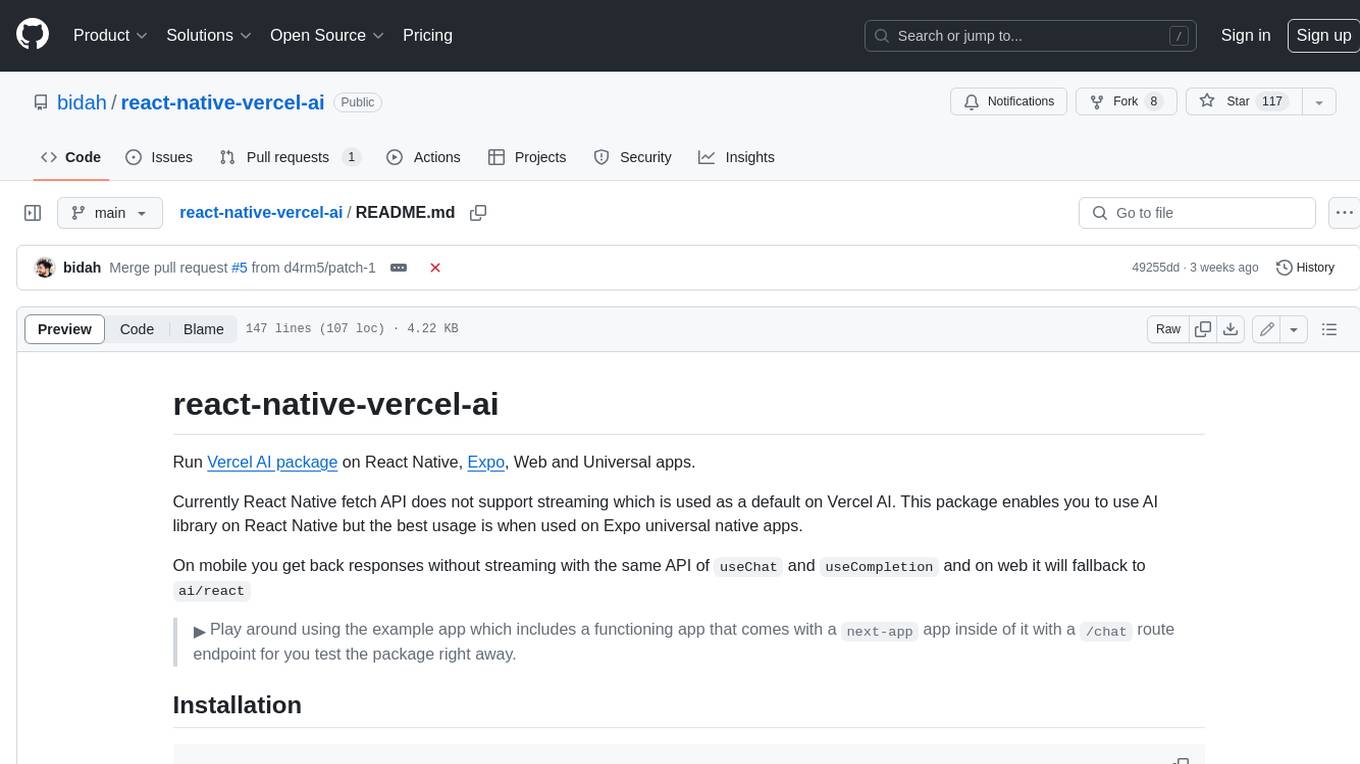
react-native-vercel-ai
Run Vercel AI package on React Native, Expo, Web and Universal apps. Currently React Native fetch API does not support streaming which is used as a default on Vercel AI. This package enables you to use AI library on React Native but the best usage is when used on Expo universal native apps. On mobile you get back responses without streaming with the same API of `useChat` and `useCompletion` and on web it will fallback to `ai/react`
For similar jobs

weave
Weave is a toolkit for developing Generative AI applications, built by Weights & Biases. With Weave, you can log and debug language model inputs, outputs, and traces; build rigorous, apples-to-apples evaluations for language model use cases; and organize all the information generated across the LLM workflow, from experimentation to evaluations to production. Weave aims to bring rigor, best-practices, and composability to the inherently experimental process of developing Generative AI software, without introducing cognitive overhead.

LLMStack
LLMStack is a no-code platform for building generative AI agents, workflows, and chatbots. It allows users to connect their own data, internal tools, and GPT-powered models without any coding experience. LLMStack can be deployed to the cloud or on-premise and can be accessed via HTTP API or triggered from Slack or Discord.

VisionCraft
The VisionCraft API is a free API for using over 100 different AI models. From images to sound.

kaito
Kaito is an operator that automates the AI/ML inference model deployment in a Kubernetes cluster. It manages large model files using container images, avoids tuning deployment parameters to fit GPU hardware by providing preset configurations, auto-provisions GPU nodes based on model requirements, and hosts large model images in the public Microsoft Container Registry (MCR) if the license allows. Using Kaito, the workflow of onboarding large AI inference models in Kubernetes is largely simplified.

PyRIT
PyRIT is an open access automation framework designed to empower security professionals and ML engineers to red team foundation models and their applications. It automates AI Red Teaming tasks to allow operators to focus on more complicated and time-consuming tasks and can also identify security harms such as misuse (e.g., malware generation, jailbreaking), and privacy harms (e.g., identity theft). The goal is to allow researchers to have a baseline of how well their model and entire inference pipeline is doing against different harm categories and to be able to compare that baseline to future iterations of their model. This allows them to have empirical data on how well their model is doing today, and detect any degradation of performance based on future improvements.

tabby
Tabby is a self-hosted AI coding assistant, offering an open-source and on-premises alternative to GitHub Copilot. It boasts several key features: * Self-contained, with no need for a DBMS or cloud service. * OpenAPI interface, easy to integrate with existing infrastructure (e.g Cloud IDE). * Supports consumer-grade GPUs.

spear
SPEAR (Simulator for Photorealistic Embodied AI Research) is a powerful tool for training embodied agents. It features 300 unique virtual indoor environments with 2,566 unique rooms and 17,234 unique objects that can be manipulated individually. Each environment is designed by a professional artist and features detailed geometry, photorealistic materials, and a unique floor plan and object layout. SPEAR is implemented as Unreal Engine assets and provides an OpenAI Gym interface for interacting with the environments via Python.

Magick
Magick is a groundbreaking visual AIDE (Artificial Intelligence Development Environment) for no-code data pipelines and multimodal agents. Magick can connect to other services and comes with nodes and templates well-suited for intelligent agents, chatbots, complex reasoning systems and realistic characters.





